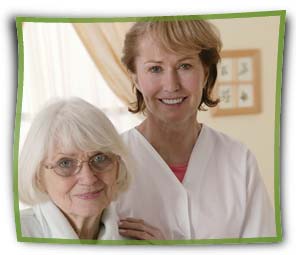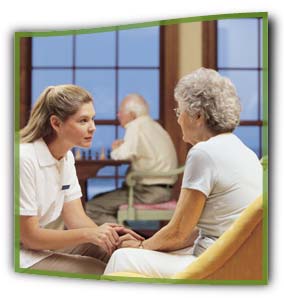 ou don’t love me—you’ve never loved me.” My mother’s words stung even more than her fingernails pressing into my arm. Trying to reason with her, I quickly found I was getting nowhere. After repeated attempts of reassurance I had to do one of the hardest things of my life—walk away and leave my mother in the care of the Alzheimer’s/dementia facility that was to be her new home.
ou don’t love me—you’ve never loved me.” My mother’s words stung even more than her fingernails pressing into my arm. Trying to reason with her, I quickly found I was getting nowhere. After repeated attempts of reassurance I had to do one of the hardest things of my life—walk away and leave my mother in the care of the Alzheimer’s/dementia facility that was to be her new home.
Feeling like a traitor, I numbly drove to my mom’s house—the place where she had spent so many happy years, the place my kids had known as “Grandma’s house” since they were babies.
Unlocking the back door, I stepped into a world that would never be the same again. Walking from room to room, seeing the pictures on the walls, the keepsakes on the shelves, the clothing in the closets, the enormity and irreversibility of the situation struck me hard—my mother would never be able to come home again.

Little signs of forgetfulness and confusion had been there longer than anyone wanted to admit, but when Mom started leaving notes around the house for her mother (who had died years ago), wandering the streets at night and walking uninvited into the homes of strangers, we knew something had to be done, but what—and how?
Living more than 3,000 miles away didn’t make things easier. Furthermore, in my mother’s mind there was no problem. Worse still, I was perceived as “the enemy,” because I had expressed concerns about her strange behavior. Although other family members tried to get Mom to consider new living arrangements, she obstinately refused to consider any other possibilities.
Then one night my phone rang. Somehow Mom had managed to drive herself to the airport, buy a ticket, and end up in Buffalo, New York—where she knew no one. A few weeks after getting back home she did it again, this time ending up at the airport in Portland, Oregon, where she planned to join her (dead) mother for a family reunion.
Now it was my turn to get on a plane. Having consulted with my uncle (who had obtained a medical power of attorney), we decided that for my mother’s safety she had to be placed in a secure facility where she would be well cared for. As much as I dreaded it, I knew what I had to do.
An Aging Population
Dealing with aging, incapacitated parents can be heartwrenching, particularly when dementia/Alzheimer’s is involved. While not everyone experiences such traumatic situations, sooner or later most will face the question of how best to care for parents who, for a variety of reasons, are no longer able to be as independent as they once were.
And the challenge is growing rapidly. In 2000 an estimated 420 million people around the globe were older than 65 years.1 By 2030 it’s expected that 973 million people worldwide will be over the age of 65.2
In the U.S.A. 35 million people were over 65 in 2000, and 9.3 million were over 80 years. By 2030, 71 million are expected to be over age 65, and 19.5 million over the age of 80.3
As people age they tend to experience more injuries, chronic illnesses, disease, and disabilities, according to the Centers for Disease Control and Prevention (CDC) in Atlanta, Georgia.4 And often it is when serious health issues arise that adult children are forced to decide how to care for their aging parents.
Difficult Choices
Sherilyn clearly remembers when her mother was diagnosed with terminal cancer. “The morning we realized what we were dealing with, my husband and I sat on our bed and cried. We talked about what this was going to mean to our family. Should we let her stay in California, with no family around, trying to get through chemo and finally death, or were we going to jump out on a limb and take care of her here?”
They decided to bring Sherilyn’s mother into their home, knowing that it would not be easy. In addition to financial cost, the new living arrangements took an emotional toll on the family.
“I found that in having her with us we got very wrapped up in the emotion that she was dying,” Sherilyn says. “It would have been a lot easier for me had she not been here—every day I watched as we lost a little bit of her. But the blessing of having her here, even though it was hard, was worth it.”
Sherilyn believes the experience also benefited her two young daughters. “Having their grandmother in our home gave the girls a year with her that they otherwise would not have had. It provided a special bonding time, and helped them to be compassionate to those who are ill and have cancer. It also modeled for them what it means to care for one’s parents.”
 But sometimes, taking a parent into the home is simply not an option. When Sandra learned that her aging mother, who lived in Canada, had ovarian and colon cancer, she knew that bringing her to the U.S. would be impossible because her mom would have no insurance coverage. So, taking several weeks off from work, Sandra went to Canada, where she cared for her mother in her childhood home. “Dealing with everything was more complicated than I had anticipated,” Sandra says, reflecting on the difficult situation.
But sometimes, taking a parent into the home is simply not an option. When Sandra learned that her aging mother, who lived in Canada, had ovarian and colon cancer, she knew that bringing her to the U.S. would be impossible because her mom would have no insurance coverage. So, taking several weeks off from work, Sandra went to Canada, where she cared for her mother in her childhood home. “Dealing with everything was more complicated than I had anticipated,” Sandra says, reflecting on the difficult situation.
Often when parents age, a role reversal takes place. After his father passed away, Michael decided to take his 93-year-old mother into his home. When he’s not at work, Michael is at home, caring for his mom.
“My parents adopted me when I was 2, and I was their only child. I don’t know where I would have been without them. And now all the headaches I gave them,” he adds with ?a smile, “are coming back to me. There’s a lot of things I just don’t get to do anymore.”
Never Easy
While some may feel that the best (and only) solution is to take mom or dad in to live with them, other options should be considered, according to Mary Dockerty, a nurse practitioner and certified gerontological nurse specialist.
“Many children now are in the ‘sandwich generation’—caught between caring for their own children and having to care for their parents,” she says. “Caring for a loved one ?in your own home can mean taking time away from your spouse and children. This may work for a while, but it can become a real burden and caretakers can become overwhelmed.” She warns that this is the point at which elder abuse can occur—physically, verbally, or by neglect. “It’s very important for someone considering this option to really think it through regarding benefits for the parent as well as the family.”
Sometimes the unknown is worse than the known, according to Don Dockerty, the administrator and coowner (with his wife, Mary) of Woodland Terrace, a Christian senior living residence in Bridgman, Michigan. The Dockertys have served seniors and their families for more than 30 years.
“I remember reading about children who were abused,” Don says. “When given the choice of staying where they were abused or going to another home, most of them chose to stay where they were. The same is true of parents. Often they realize they need more help and are not able to do things for themselves. But they fear change and uncertainty, and would rather stay in their homes than go into unknown, new circumstances.”
How to Choose
The best thing to do, advise the Dockertys, is to talk with your parents before a crisis comes. “Ask them what they would plan to do if they needed more help and offer options they should think about,” Mary says. “Remind them that we don’t lose our memories when we leave our home.”
“Look at the various options and then decide where the parent will have the highest quality of life,” Don advises. “If they will be coming into your home, will there be someone ?to fix regular meals? Will there be someone to socialize with during the day, or will the relative be left alone?”
If a long-term care facility is being considered, it’s crucial to look thoroughly at the facility (see sidebar). “It’s very important that the residents are interacting and not just sitting in front of a TV all day,” Mary adds.
“Many people have the traditional view of nursing homes as institutions where people go to die,” Don says. “They do not realize that there are assisted living facilities that are much more homelike, with the advantage of having immediate help available 24 hours a day.”
Senior living specialists advise that adult children talk with parents about their wishes for medical decisions and encourage them to make a living will and (written) advanced directives before the senior gets to the point of needing care. In addition, someone should be appointed to make medical decisions if the senior is unable.
A New Perspective
After putting my own mother into a dementia care home, I soon learned that many things still needed attention. Her home—and everything in it—had to be gone through and decisions made. Fortunately, I did not have to deal with this alone, as my uncle handled all the business/legal aspects and helped to sort through my mother’s lifetime collection of stuff.
 Going through these items was a bittersweet experience for me. Sometimes I was amazed at what I found—a receipt dated in August 1958 from the florist who provided the flowers for my parents’ wedding, and a collection of “masterpieces” I had painted in kindergarten!
Going through these items was a bittersweet experience for me. Sometimes I was amazed at what I found—a receipt dated in August 1958 from the florist who provided the flowers for my parents’ wedding, and a collection of “masterpieces” I had painted in kindergarten!
And then there were the old pictures—bringing back memories from long ago. As I gazed at the black-and-white photos of my mother and grandmother—taken when they were much younger than I am now—I came face-to-face not only with their mortality but also my own.
I was learning a valuable lesson—that change is inevitable. Life on this earth is only temporary, and aging is a normal process of that life. As I come to terms with that thought it frees me to find joy in the moment and hope for the future, when God will make all things new.
Recently, I went back to visit my mom in her new home. Smiling when she saw me, she told me how nice it was not to live alone and introduced me to all her new friends. The memory of how she got there had already been erased.
__________
1U.S. Census Bureau. International database. Table 094. Midyear population, by age and sex. Available at www.census.gov/prod/2001pubs/c2kbr01-10.pdf.
2Ibid.
3K. Kinsella, V. Velkoff, U.S. Census Bureau. An Aging World: 2001 (Washington, D.C.: U.S. Government Printing Office, 2001), series P95/01-1.
4“Public Health and Aging: Trends in Aging.” Morbidity and Mortality Weekly Report, Centers for Disease Control and Prevention, Department of Health and Human Services. Available at www.cdc.gov/-mmwr/preview/mmwrhtml/mm5206a2.htm.
________________
Gina Wahlen has been sharing her faith through writing for the past 25 years. She and her husband, Clinton, live in Silver Spring, Maryland. They have two children: Daniel 18, and Heather, 12. This story was published January 21, 2010.

![]() ou don’t love me—you’ve never loved me.” My mother’s words stung even more than her fingernails pressing into my arm. Trying to reason with her, I quickly found I was getting nowhere. After repeated attempts of reassurance I had to do one of the hardest things of my life—walk away and leave my mother in the care of the Alzheimer’s/dementia facility that was to be her new home.
ou don’t love me—you’ve never loved me.” My mother’s words stung even more than her fingernails pressing into my arm. Trying to reason with her, I quickly found I was getting nowhere. After repeated attempts of reassurance I had to do one of the hardest things of my life—walk away and leave my mother in the care of the Alzheimer’s/dementia facility that was to be her new home. 
 But sometimes, taking a parent into the home is simply not an option. When Sandra learned that her aging mother, who lived in Canada, had ovarian and colon cancer, she knew that bringing her to the U.S. would be impossible because her mom would have no insurance coverage. So, taking several weeks off from work, Sandra went to Canada, where she cared for her mother in her childhood home. “Dealing with everything was more complicated than I had anticipated,” Sandra says, reflecting on the difficult situation.
But sometimes, taking a parent into the home is simply not an option. When Sandra learned that her aging mother, who lived in Canada, had ovarian and colon cancer, she knew that bringing her to the U.S. would be impossible because her mom would have no insurance coverage. So, taking several weeks off from work, Sandra went to Canada, where she cared for her mother in her childhood home. “Dealing with everything was more complicated than I had anticipated,” Sandra says, reflecting on the difficult situation. Going through these items was a bittersweet experience for me. Sometimes I was amazed at what I found—a receipt dated in August 1958 from the florist who provided the flowers for my parents’ wedding, and a collection of “masterpieces” I had painted in kindergarten!
Going through these items was a bittersweet experience for me. Sometimes I was amazed at what I found—a receipt dated in August 1958 from the florist who provided the flowers for my parents’ wedding, and a collection of “masterpieces” I had painted in kindergarten!